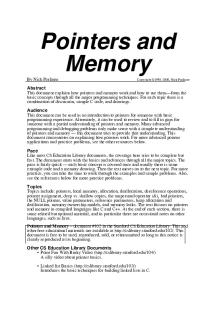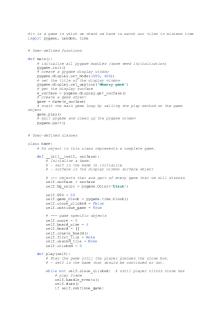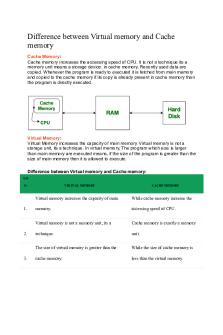Week 3- Memory and intelligence PDF

| Title | Week 3- Memory and intelligence |
|---|---|
| Course | Individual Determinants Of Health |
| Institution | La Trobe University |
| Pages | 7 |
| File Size | 465.7 KB |
| File Type | |
| Total Downloads | 40 |
| Total Views | 135 |
Summary
Memory, factors affecting memory storage, sensory memory, short-term memory, long-term memory, affect of stress on memory, using memory in clinical practice. ...
Description
MEMORY Learning objectives – In relation to memory, by the end of this week you should be able to: • Describe the stages of memory; • Examine factors that can influence storage and retrieval of memory; • Explore and apply memory processes to demonstrate how people present and interact in health and human services settings; and • Explore and apply memory processes to demonstrate how to facilitate change in people in health and human service settings. WHAT IS MEMORY? → Gerrig: The mental capacity to encode, store and retrieve information -
-
It is a memory involving the interactions of brain/behaviour/environment Related to learning is the relatively permanent change in knowledge and behaviour o Eg learn language by studying it. Speak by using memory to retrieving words we’ve learnt. o Sensory memory→ Short term→ Long-term memory Depends on 3 sequential processes: o Encoding→ process by which a mental representation if formed in memory. It is where incoming information is processed. o Storage→ Retention of encoded material over time. o Retrieval→ Ability to access or recall stored information over time so it can be used or accessed.
Factors that impact the storage of memory: -
-
-
Interference→ difficult to remember something if you have been trying to memorise similar information. Eg memorising words which sound similar. Can be proactive or retroactive. o Proactive interference→ old memories interfere with new ones o Retroactive interference→ new information distorts old memories. Life events can impact storage of memory and organic causes such as anterograde amnesia which is the prevention of new memories being formed after trauma. ‘ o Retrograde amnesia can impact the retrieval of memory. This refers to the loss of old memories that are formed before trauma. Health factors impact retrieval of memory. Context, environment, health, stress, illness, concentration or attention processes when trying to remember something can cause an impact on retrieval of memory.
Different types of memory: Sensory store, short term, long term
1. Sensory Memory→ shortest-term element of memory. Purpose: keep information around for further processing which can take time. Our senses are directly linked to our CNS, therefore process happens quickly and we may not be consciously aware of what is being picked up by our senses. THUS, the sensory memory stores incoming sensory info in detail but only for short period of time as it makes its way to our consciousness. o Eg: person sees an object briefly before it disappears. Once the object is gone, it is still retained in the memory for a very short period thanks to sensory memory so brain can decide what is useful and what is not. - Iconic Memory→ Visual sensory memory. o Visual images are taken in through the photoreceptor cells in the eyes and then transmitted to the occipital lobe of the brain where the sensory memory is briefly stored. ▪ Eg: look at an object. Close your eyes and still see object in seconds. - Echoic Memory→ Auditory sensory memory o Auditory stimuli are picked up by the hair cells in the ears and transmitted to the temporal love of the brain where the auditory memory is stored for less than a second. ▪ Eg: When you are listening to someone speak in the background and they stop speaking but you still hear the tone or pitch of their voice, this is echoic memory working. 2.Short-term memory→ Refers to a memory process associated with the preservation of recent experiences and with retrieval of information from long-term memory. Some info from sensory memory can be transferred to short term memory → holds info for 20 seconds. Rehearsing retains memory for longer. - Key aspects: o Limited capacity- about 7 (-/+ 2) items stored at a time o Limited duration – fragile as info can be lost with distraction, interference or passage of time. o Retention is facilitated by repetition and rehearsal - Ways to forget info in short term memory: o Decay- occurs when you do not rehearse, therefore do not contemplate it o Displacement- new memories replace old ones o Interference- distortion due to similar memories Since short-term memory is limited to capacity and duration, the retention of memories requires transferring the info from short-term stores into long-term memory. o Eg chunking info is a memorisation technique→ info broken into smaller segments. o Rehearsal→ go over notes until critical info is committed to long term memory 3.Long-term memory→ Refers to the memory processes associated with the preservation of information for retrieval at any time. Can last from days to decades. - Declarative (explicit) memory→ Info available consciously, such as facts and events 1. Episodic memory→ Autobiographical events, images. Eg first day of school, first pet. 2. Semantic memory→ facts and generalised information Eg meaning of words, rules, problem solving skills, etc. Easily stored if meaningful. - Procedural (implicit) memory→ How to get things done, perceptual, cognitive, motor skills are acquired, retained and used 1. Memory of body movement and how to use objects 2. How to drive a car, ride a bike or use a computer
MEMORY IN HEALTH AND HUMAN SERVICE SETTING: Forgetting in health and human service setting: - Importance for health care: 1. Diagnosis- patient’s memory of clinical history. Forgetting may lead client to provide inaccurate or unclear information that can result in inaccurate diagnosis. 2. Compliance- patient remembering to follow actions. Client may forget instructions that a health professional has provided and consequently, lack compliance to medical advice. - Organic causes of forgetting→ when brain experiences physiological damage (due to injury, disease or psychological trauma) which causes forgetting, it is known as organic causes. 1. Failure of memory due to diseases such as Dementia, Alzheimer’s and acquired brain injury 2. Self-imposed damage such as excessive consumption of alcohol or drugs 3. Psychological trauma or stress Memory and stress - High levels of stress impact memory, whether chronic or acute. Stress affects working memory and long-term memory. Long-term repeated exposure to stress hormone cortisol can lead to physical damage of brain cells in the hippocampus which is the primary location in the brain for memory formation and retrieval. 1. Bob going through divorce→ forgets about diabetes medication 2. Jane diagnosed with lymphoma→ forgot to attend specialist appointment - When teaching someone in health and human service setting, it is important to acknowledge the importance of the context 1. Eg: in order to facilitate accurate storage and recall, when showing Kim how to bath her baby, you would demonstrate exactly how to do it in an actual bath with her baby. Just explaining how to do it may not be enough for Kim to encode, store and retrieve the information. Memory in clinical practice: -
Patients may not remember or act on advice because health professionals did not follow basic instructions: 1. Attention rehearsal- was the info encoded? If info was just in short term memory, then it will likely not be retained. Need to ensure they remember the information by letting them rehearse. 2. Depth of processing- was the info meaningful? If so, it is likely to lock into an existing scheme and be consolidated in their memory. If their level of health literacy is low then you might be talking in medical language or jargon that doesn’t make any sense to them and it will be hard for them to encode, store and retrieve info. 3. Interference- was there conflicting info from diverse sources? Was the verbal info combined with a written formal to facilitate memory processes? 4. Cue-dependent- where did the encoding take place? Did they have the chance to transfer the information from a particular setting to their home (eg Kim and baby)? 5. Mood-dependent- what was the patient’s emotional state? Were they stressed or experiencing anxiety or low mood? If so, additional measured needs to be employed to ensure they remember the info presented, eg ask them to repeat info, ask them to write info down. 6. State-dependent- was the patient on medication? 7. Amnesia/dementia- Has the patient got a CNS disorder?
INTELLIGENCE Learning Objectives: • Identify and explore the difference between cognitive and emotional intelligence; • Examine the theoretical perspectives of cognitive intelligence; • Describe the strengths and limitations of IQ testing; and • Examine the dimensions of emotional intelligence. Intelligence→ → Refers to one's capacity to perceive, think, feel and act in a way that effectively manages environmental demands and helps achieve constructive outcomes According to Legg and Hutter→ Intelligence measures an agent’s ability to achieve goals in a wide range of environments
Cognitive Intelligence→ refers to capacity to understand, learn, recall, think rationally, solve problems and apply what has already been learnt - Intellectual abilities such as: Logic, reason, reading, writing, analysing, prioritising ▪ Come from the brain and used for high order functioning: sensory perception, generation of motor commands, conscious thought and language. ▪ NOT TO BE CONFUSED WITH PIAGET’S COGNITIVE DEVELOPMENT AS THAT IS SONCERNED WITH STAGES NEEDED FOR CHILDREN TO DEVELOP KNOWLEDGE AND INTELLIGENCE TO REASON INDEPENDENLY. Binet-Simon scale -French Government wanted French students to attend school. Asked experts to decide which students were most likely to experience difficulty in schools. Goal was to find a way to identify children who would need specialised educational assistance. Binet and Simon developed 30 questions that focused on things not taught at school which were presented in increasing order of difficulty. Binet suggested that the concept of a mental age, or measure of cognitive intelligence is based on average ability of children of a certain age group. Some questions in Binet-Simon test includes: • Participant's capacity to recognise food (eg discriminate chocolate and wood) • Participant's ability to define familiar objects (define fork) • Participant's ability to define and differentiate a pair of abstract terms (eg sad, bored) Based on child’s score, children were designed to one of three levels of intellectual deficiency. No longer employed due to derogatory connotation they acquired over the years. They used to be: idiot (most severe form of intellectual impairment), imbecile (moderate levels of impairment) and moron (mildest level). Only produced score by measuring verbal, reading and language abilities at the expense of other cognitive skills such as integration of visual and motor functioning. - The scale was further developed but grouped items in order of age level than increasingly difficult items. 65 questions adapted to children from 3-13 age. - Aim: provide a measuring scale where intellectual performance of child compared to average typical child of same age. Unpredictable task: educational performance or attainment. Too broad. Stanford-Binet Intelligence Scale developed in 1916.
Problems with Stanford-Binet: - Had been selected for use with children→ not appropriate for adults to compete - Did not consider that the cognitive performance can deteriorate as person grows older - Only produced one score→ which Binet disagreed with as he believed cognitive intelligence involved a variety of different mental abilities. Therefore, he developed multiple versions of a cognitive intelligence test to target different age groups and provide scores for various different domains of cognitive development. Wechsler intelligence scales • Developed first by David Weshsler in 1939 • Addressed problems with Stanford-Binet scale. • Adult, child and pre-school versions o Wechsler Adult Intelligence Scale - 4th edition (WAIS-IV) o Wechsler Intelligence Scale for children- 5th edition (WAIS-V) Use different measures of cognitive intelligence: WISC-V→ measures five broad dimensions of cognitive intelligence: • Verbal comprehension • Visual spatial reasoning • Fluid reasoning • Working memory • Processing speed WAIS-IV→ measures four broad dimensions of cognitive intelligence: • Verbal comprehension • Perceptual reasoning→ combination of fluid reasoning and visual-spatial reasoning • Working memory • Processing speed FROM THESE SCORES, PSYCHOLOGISTS CAN CALCULATE A FULL-SCALE IQ SCORE WHICH IS A MEASURE FO AN INDIVIDUAL’S GENERAL COGNITIVE FUNCTIONING NOTE: Everyone has a unique pattern of strengths and weaknesses. Therefore, one score, the Full-Scale IQ, may not necessarily indicate an individual’s success rate. Wechsler intelligence scales: • Verbal comprehension→ Refers to the overall fund of knowledge and understanding based upon previous learning experiences including your knowledge or language and vocabulary • Visual-spatial→ refers to ability to perceive, analyse and think with visual patterns • Fluid reasoning→refers to ability to use reasoning to solve unfamiliar problems, reason, form concepts and novel procedures. • Working memory→ ability to sustain attention, concentrate and exert mental control • Processing speed→ refers to ability to fluently and automatically perform cognitive tasks, particularly when under pressure to maintain focused attention and concentration • Perceptual reasoning→ ability to understand non-verbal concepts, organise visual information spatially, process info simultaneously and display visual-motor coordination (comprise fluid reasoning and visual-spatial reasoning).
Remember: IQ scores are based on a combination of strengths and weaknesses so the cut-off point of 70 is quite arbitrary and can be contentious issue in a variety of health and human service setting
Emotional Intelligence→ → refers to ability to perceive, understand, manage and use emotions - NOTE: EQ (emotional Intelligence) is just as important as IQ (Intelligence Quotient) - Some day: ‘emotional intelligence is the ability to understand your own emotions and the emotions of the people around you’ Components: - Salovey and Mayer: first researchers to posit a clear theory of EQ. They proposed model that identified four different factors of emotional intelligence: 1. The perception of emotion→ understanding body language and facial expressions. Understand nonverbal signals. 2. Reason with emotions→ promote thinking and cognitive activity. Emotions help prioritise what we pay attention and react to 3. Understand emotion→ perceive someone’s emotions and interpreting them. If someone is angry, observer must interpret anger and reason for it. 4. Manage emotions→ regulate emotions and respond to others
Social awareness example: -
-
-
-
A clinician's social awareness can influence his or her relationship with a patient. For example, a clinician who can notice a patient's nonverbal and verbal cues will perceive when a patient needs more clarification, or simple comfort. The use of interpersonal communication skills such as active listening, reflective responding, and validating emotions can have a lasting impression on a vulnerable patient, and may improve patient and clinician collaboration, thereby improving the overall care. Simple recognition and validation of the patient's emotional state can make a lasting impression on a patient. A healthcare worker who demonstrates empathy is likely better able to establish a trusting relationship with their patients, which may result in more productive interactions and outcomes for the patient. Empathetic communication may enhance the therapeutic effectiveness of the clinicianpatient relationship. Additionally, incorporating empathy into communication allows for a smoother exchange of medical information and demonstrates the provider's respect for the feelings and needs of their patient. What predicts successful performance is not always cognitive intelligence, as much as personality, motivation or the ability to perceive emotions. Emotional Intelligence is important for a number of reasons when working in a health and human services setting as on the whole it can often determine how we manage relationships. We can support our clients abilities through feedback and guidance. Being able to recognise and meet our clients’ needs means better outcomes for all....
Similar Free PDFs

Week 3- Memory and intelligence
- 7 Pages

Week 3 epa - memory
- 3 Pages

Chapter 3 Learning and Memory
- 20 Pages

Pointers And Memory
- 31 Pages

Notes - Memory and Cognition
- 146 Pages

Pointers And Memory
- 31 Pages

Memory
- 3 Pages

Memory
- 5 Pages

Everyday Memory and Errors
- 4 Pages

In Week 3 - Week 3
- 1 Pages

Week 3 Meaning and Semiotics
- 4 Pages
Popular Institutions
- Tinajero National High School - Annex
- Politeknik Caltex Riau
- Yokohama City University
- SGT University
- University of Al-Qadisiyah
- Divine Word College of Vigan
- Techniek College Rotterdam
- Universidade de Santiago
- Universiti Teknologi MARA Cawangan Johor Kampus Pasir Gudang
- Poltekkes Kemenkes Yogyakarta
- Baguio City National High School
- Colegio san marcos
- preparatoria uno
- Centro de Bachillerato Tecnológico Industrial y de Servicios No. 107
- Dalian Maritime University
- Quang Trung Secondary School
- Colegio Tecnológico en Informática
- Corporación Regional de Educación Superior
- Grupo CEDVA
- Dar Al Uloom University
- Centro de Estudios Preuniversitarios de la Universidad Nacional de Ingeniería
- 上智大学
- Aakash International School, Nuna Majara
- San Felipe Neri Catholic School
- Kang Chiao International School - New Taipei City
- Misamis Occidental National High School
- Institución Educativa Escuela Normal Juan Ladrilleros
- Kolehiyo ng Pantukan
- Batanes State College
- Instituto Continental
- Sekolah Menengah Kejuruan Kesehatan Kaltara (Tarakan)
- Colegio de La Inmaculada Concepcion - Cebu




